Posts Tagged ‘Abraham’
How long was the Israelite Sojourn in Egypt?
It was foretold to Abraham in a dream that his descendants would serve as slaves in a foreign land for 400 yrs (or 4 generations of priests). Genesis 15:12-16
Yet the Bible also tells us that the Israelites lived in Egypt for 430 years to the very day. Exodus 12:40-41
The Israelite Oppression ended when the 12th dynasty ended, about 10 years after Moses / Amenemhet IV went into exile at the age of 40 years. This was 400 years after Jacob and his family came to Egypt. The Exodus did not take place until 30 years into the 13th dynasty when Moses / Amenemhet IV returned to confront Neferhotep I at the age of 80 years.
The Israelite oppression lasted 400 years – it ended when the 12th dynasty ended. No more pyramids were built after the 12th dynasty. The 13th dynasty was very chaotic and the Pharaohs did not focus on oppressing the Israelites because their thrones were not stable enough and maybe their attitude towards the Israelites was slightly more sympathetic than that of the 12th dynasty pharaohs. The Exodus occurred 30 years into the 13th dynasty during the reign of Neferhotep I who was the longest ruling pharaoh of that dynasty (11 years).
Amenemhet III would have reigned between 2-6 years after Moses fled to Midian and Sobekneferu would have reigned between 4-8 years after her father Amenemhet III and then she died. When she died, the 12th dynasty ended as there was no heir to the throne. The result was that Egypt fell into Chaos. There was a rapid succession of Pharaohs in the 13th dynasty and as a result, the Israelites were not oppressed during this time. They were able to keep multiplying and prepare to leave Egypt.
The Exodus occurred exactly 40 years after Moses fled to Midian and about 30 years after the 12th dynasty ended with the death of Sobeknefru.
The major objection to Joseph being Imhotep is the dates, however, new insights into the Egyptian chronology are slowly but surely resolving this issue.
There are many theories about who Joseph was in Egyptian History. Similarly, people theorize about who was the Exodus Pharaoh and who was the Pharaoh of Moses Birth and who was the pharaoh of Abraham.
As these Biblical and Historical figures are related to each other in time, sequence and position, the identification of one of these figures (a point of reference) determines where and when to look for the others.
As there are different views about the way the various Egyptian dynasties are ordered and as there are two schools of though regarding the length of the Israelite’s Sojourn in Egypt, many different permutations and combinations are possible when everybody logs in their answers for who they think just four of these iconic Biblical figures may have been in Egyptian History.
For a theory to hold, there needs to be a good character match, sufficient archaeological evidence, any discrepant dates need to be explained and the sequence and time frames needs to be right.
As a point of reference, one might ask, what lasting legacy did the Israelites leave behind (for us to find) when they were slaves in Egypt? The Bible records that the Israelites were forced to make mud bricks that were reinforced with straw. The Bible says that there were over 600 thousand Israelite men of fighting age by the time of the Exodus. The Bible says that the Israelites Sojourned in Egypt for 400 years.
Even if the the Israelites only produced one mud brick per person per day for half of their sojourn, that would be 600000 people x 200 years x 365 days x 1 mud brick per day per person = 43.8 billion mud bricks.
That is a lot of mud bricks!!
Where can we find this many mud bricks in Egyptian History?
The answer is: In the 12th dynasty (and the 12th dynasty lasted about 200 years)!!

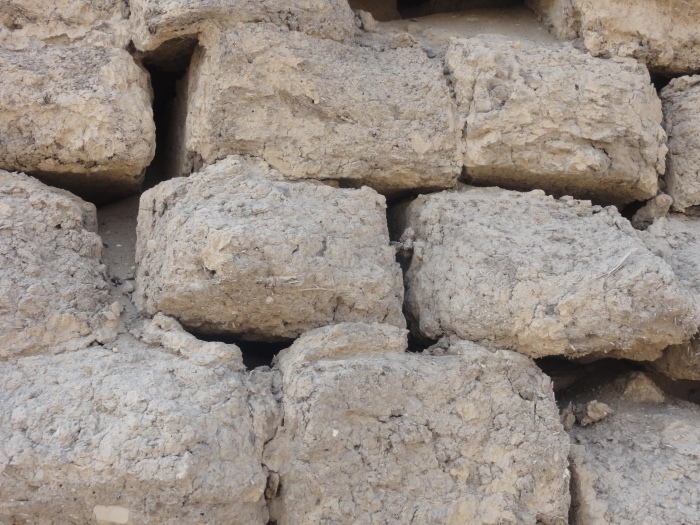
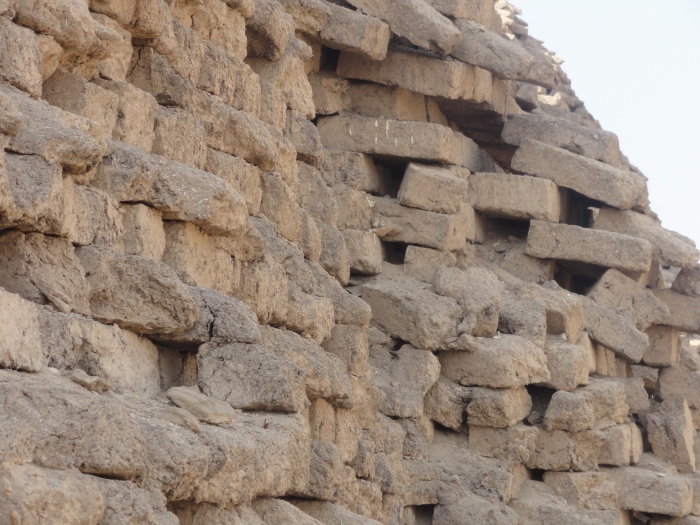


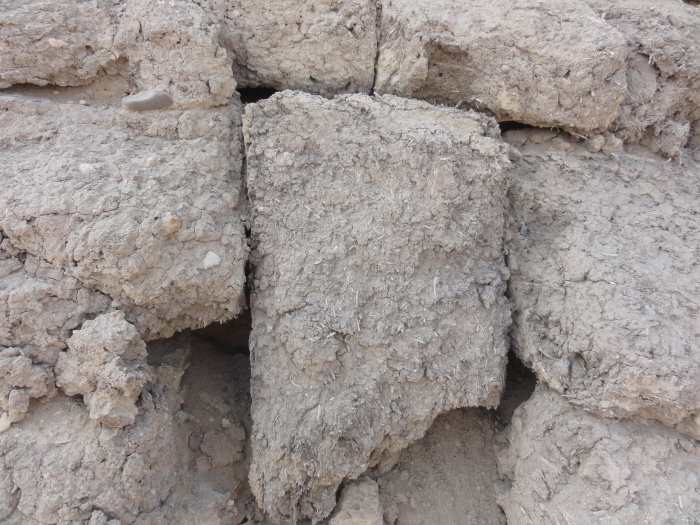
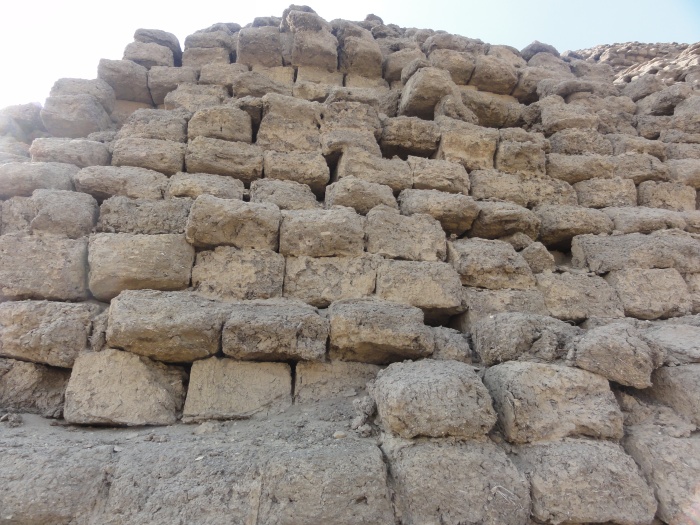
There is considerable evidence to suggest that the 12th dynasty was the period when the Israelites were oppressed. The 12th dynasty pyramids had a mud brick core and a limestone veneer. (The limestone veneer has fallen away over the centuries leaving the mud brick core exposed.) There were seven such pyramids constructed over about 200 years. The Labyrinth, another monolith of the 12th dynasty, was also made from mud bricks.
There was a massive Exodus of slaves from Egypt in the 13th dynasty, after which, no more pyramids were constructed.
The only other significant exodus from Egypt was at the end of the second intermediate period when The Hyksos were chased out of Egypt in a rebellion lead by the family of Ahmose who went on to found the 18th dynasty. The Hyksos were rulers of Egypt and are clearly not the Israelites.
The only reasonable conclusion is that the Exodus of slaves in the 13th dynasty was in fact the Israelite Exodus. This is supported by good character matches for Moses, Moses’ pharaoh, Moses’ adoptive mother and the Exodus pharaoh. The profiles of Amenemhet III, Sobekneferu Amenemhet IV and Neferhotep and the chronology and time frames make it very likely that they were The pharaoh of Moses Birth, the princess that adopted Moses, Moses himself and the Exodus pharaoh respectively.
People have suggested the 12th dynasty vizier Mentuhotep (of Sesostris I) to be Jospeh of the Bible based on a 200 yr sojourn but there is little evidence and a poor character match.
The Bible says that the Israelites were in Egypt for 400 years. They were able to enjoy the protection of Joseph for the first 70 years and some time elapsed before there was a change of dynasties to a pharaoh who neither remembered Joseph, nor was sympathetic to the Israelites.
It is unlikely that the Pharaohs of the 12th dynasty changed their tune half way thru the dynasty.
There is a lot of evidence to suggest Joseph was Imhotep of the third dynasty and this would fit with Menez being Mizraim. Abrahams pharaoh (Abimelech) was somewhere in between Menes and Imhotep.
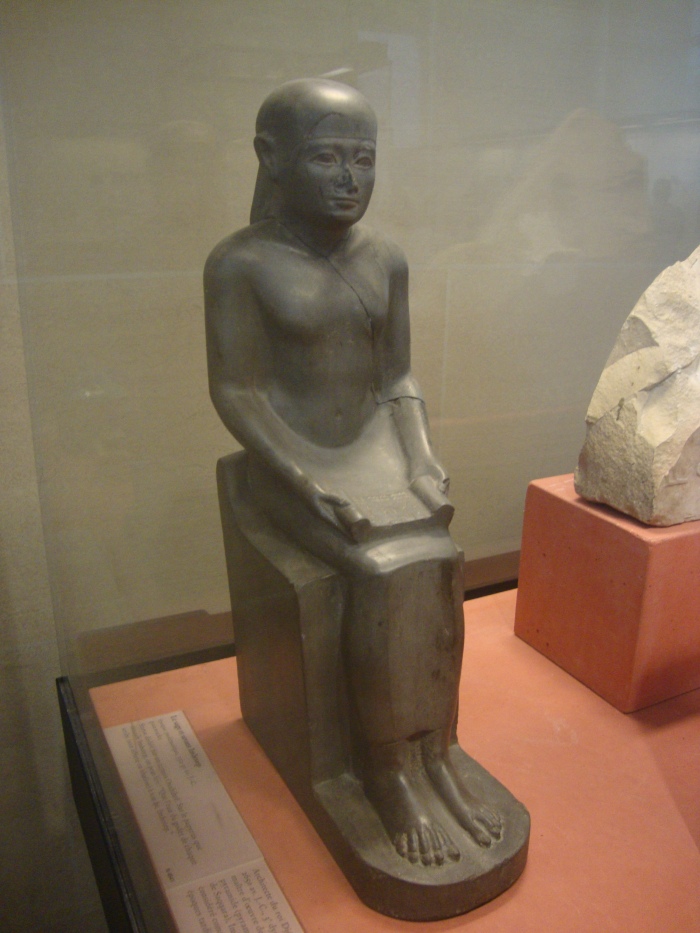
A statue of Imhotep in the Louvre.
It is likely that he is the Joseph of the Bible who saved Egypt from a 7yr famine buy building grain silos such as these in cities around Egypt.
He was able to buy up all the land of Egypt with the proceeds from selling the grain. This had to take place early in Egypt’s history. Joseph and Imhotep have many other similarities. For example, they both lived to the age of 110yrs, were embalmed when they died and given a royal Egyptian burrial, they imposed a 20% tax and they both married the daughter of the high pries of On. They both saved Egypt from a 7 yr famine. They were both visiers of non-royal blood.
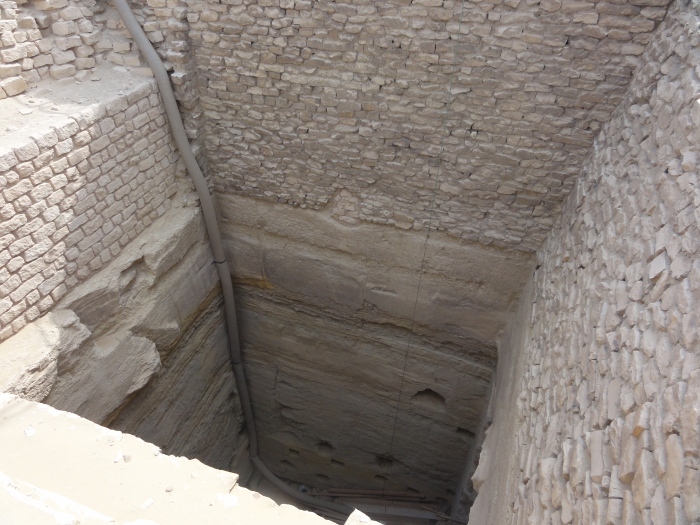
A grain silo in the Step Pyramid complex. Access to the bottom of the silo is from the steps in the pit next to it.
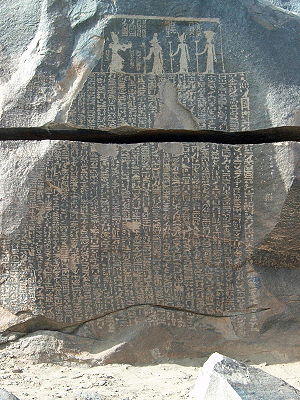
The Famine Stele. Inscription number 81. Carved on a high point on the Island of Sehel during the Ptoleemaic period. It mentions Djoser, Imhotep and a seven year famine. It also makes reference to Djoser giving land to the priests of Khnum. (The priests of Isis also make the same claim elsewhere).
We know that the Egyptian chronology has been stretched out too far, that dynasties overlapped and so we cannot use dates to match Biblical figures with their historical counterparts.
If the long sojourn is right, then Joseph would have arrived in Egypt about 200 years before the 12th dynasty began.
The first intermediate period is likely to have been contemporary with other dynasties (3-6th dynasties). As a consequence, the 12th dynasty (middle kingdom) followed directly on from the old kingdom (dynsasty 3-6).
The pharaohs of the dynasties 7-11 (erroneously referred to as the First Intermediate Period) were probably Nomarches and high officials and not pharaohs at all. The only record we have of them is there name and how long they reigned. They were not even buried in pyramids.
Amenemhet I who founded the 12th dynasty was the vizier of Mentuhotep IV of the 11th dynasty. Amenemhet I assassinated Mentuhotep IV and took over the whole country. It was he who had a different attitude to the Israelites and made them into slaves, forcing them to make mud bricks for the 12th dynasty pyramids.
The major objection to Joseph being Imhotep is the dates, and new insights into the Egyptian chronology are slowly but surely resolving this issue.
I think it is likely Joseph was Imhotep. Hopefully, as new evidence comes to light, we will understand Egyptian chronology better and reconcile the dates.
In any case, I have no doubt that the Bible is true and that Moses and Joseph were real people and one day we will know their Egyptian names and the names of the Pharaohs that they served with more certainty.
Nigel Hawkins
The Genealogy of Joseph
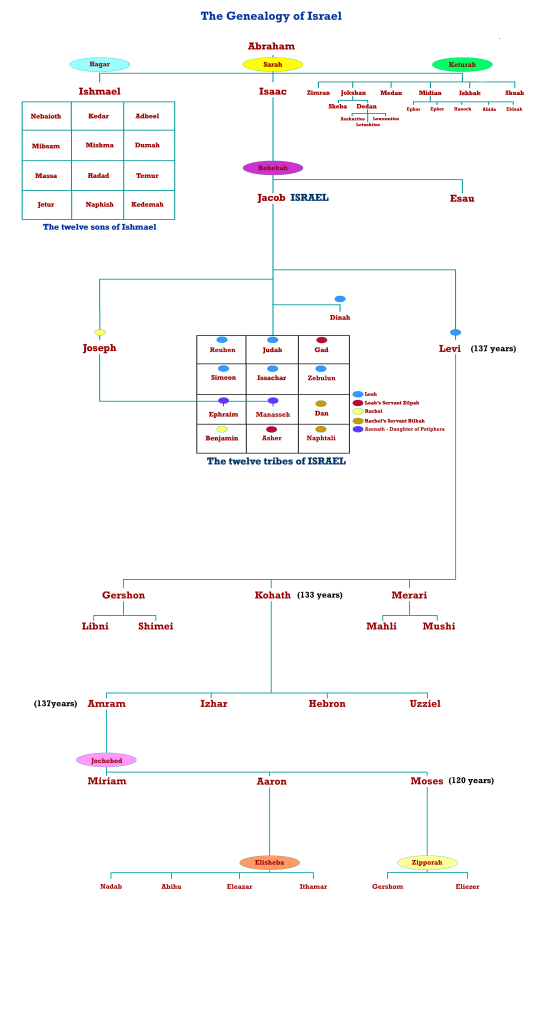
The genealogy of Israel from Abraham to Moses (with the ages of the Levites) according to the Bible
Placing Joseph in the 3rd dynasty and Moses in the 12th dynasties not only fits very well with the archaeological evidence, it fits very well with the Biblical account and shows how Majestic God is.
Many scholars now realize that Moses was born during the 12th dynasty when Amenemhet III was pharaoh and the Exodus occurred around 1445bc during the 13th dynasty when Neferhotep was Pharaoh.
There is much archaeological evidence to support this revelation, however, it means that the traditional dates of the 12th and 13th dynasties need to be revised.
http://www.diggingsonline.com/pages/rese/dyns/yusef.htm
When it comes to locating Joseph in the history of Egypt, there are two schools of thought.
The Bible says that the Israelites sojourned in Egypt for 430 years. Exodus 12:40 says “the length of time that the Israelites live in Egypt was 430 years.”
The New Testament also refers to this 430 years. Galations 3:17 says ” The law, introduced 430 years later, does not set aside the covenant previously established by God and thus do away with the promise. ”
Because of this many scholars believe that the 430yrs commenced with the promise being given to Abraham 215yrs before Jacob and his family moved to Egypt.
The result of this is that some scholars believe that Joseph came only 215 years before Moses lead the Israelites out of Egypt.
http://www.ancientexodus.com/topics/index/new-york-times-book-review/
http://www.specialtyinterests.net/exodus.html
Other scholars believe that the Joseph was 430 years before the Exodus.
Joseph went to Egypt some 9-10 yrs before Jacob did.
When Jacob and his family went to Egypt, the Israelites numbered about 70. When they left Egypt they numbered around 2 million. They needed time time multipy to this number. Not withstanding this, it is obviously very important to know whether the Isralites were in Egypt for 430 years or 215 years so that we know in which dynasty to look for Joseph.
It is also important to know how the Egyptian dynasties are ordered.
People who believe in a 215 yr sojourn in Egypt look for Joseph earlier in the 12th dynasty and have nominated Mentuhotep as a possibility.
People who believe in a 430yr sojourn in Egypt look for Joseph in an earlier dynasty and given the similarities between Joseph and Imhotep, have tended to place Joseph in the 3rd dynasty.
Placing Joseph in the 3rd dynasty would require an even greater revision of Egyptian history and a complete revision of the Chronology to allow for parallel dynasties running concurrently in the North and the South and also for the common practice of coregency.
This would bring Egyptian history into complete agreement with the Bible.
One of the problems of placing Joseph in the 12th dynasty means that the flood of Noah would most likely have occurred during during one of the earlier dynasties (2450bc) and this is not only out of keeping with the Bible but there is no archaeological evidence of a worldwide flood during any Egyptian dynasty.
The Bible records that Noah had a grandson named Mizraim who seems to be one of the Patriarchs of Egypt. The flood would, therefore, have preceded even the predynastic periods of Egyptian History.
Even Manetho, whom most archaeologist regard as the most authoritative source of information on the chronology of Egyptian history, believed that Mizraim and Menes (the first Pharaoh) were the same person.
Placing Joseph in the 3rd dynasty and Moses in the 12th dynasties not only fits very well with the archaeological evidence, it fits very well with the Biblical account. What we know about these people from the Historical records can then be used to fill in the gaps in the Biblical record revealing how miraculous, amazing and glorious the Hand of God has been in dealing with mankind.
Dr Nigel Hawkins
